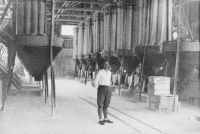- Industries & Machines Industries & Machines
- IIoT IIoT
- Service-Toll Processing Service-Toll Processing
- Material Material
- News News
- IR Information IR Information
-
Sustainability
Sustainability
Sustainability
- Introduction
- Hosokawa Micron Group "Basic Human Rights Policy"
- Hosokawa Micron Group "Basic Policy on the Environment"
- Sustaibality Policy - Mission Statement
- Editorial Policy
- Integrated Report
- Materiality & Strategy
- Technological contribution to a sustainable global environment
- Contributions towards a safer, more secure and prosperous society
- Sophistication of governance that supports business
- ESG Data Collection
- Sustainable Business Management ~ Finance
- Infromation Disclosure Based on TCFD Recommendations
- Jobs and Careers Jobs and Careers
-
About Us
About Us
About Us
- Greetings (Company Introduction)
- Hosokawa Micron Group "Basic Human Rights Policy"
- Hosokawa Micron Group "Basic Policy on the Environment"
- Management Philosophy
- Corporate Overview
- Executive Officers
- Corporate Profile
- Business Areas and Strengths
- Corporate History
- Hosokawa Micron Group
- Domestic Facilities
- Overseas Subsidiaries (Asia)
- Overseas Subsidiaries (Europe)
- Overseas Subsidiaries (America)
- Asian Agents
- Powder Technology Research Institute
- Industrial Property Rights
- Journals and Books
- Technical Information
- Annual Publication "Micromeritics"
- Compliance Charter
- Privacy Policy
- Cookie Policy
- Quality Principle

About Us
- TOP
- About Us
- Corporate History
- One invention helps a local industry to flourish
- Greetings (Company Introduction)
- Hosokawa Micron Group "Basic Human Rights Policy"
- Hosokawa Micron Group "Basic Policy on the Environment"
- Management Philosophy
- Corporate Overview
- Executive Officers
- Corporate Profile
- Business Areas and Strengths
-
Corporate History
- The founder's relationship with powder technology
- Episode of Eiichi Hosokawa, the founder
- One invention helps a local industry to flourish
- Relationship with powder engineering
- European expansion by a single Japanese
- The relationship between Hosokawa Micron and measuring instruments
- M&A and Mountain range of powder technologies
- Tidbit of M&A
- Expansion into South East Asia
- The beginning of the nanotechnology-based materials business
- Full-scale development with a view to energy reduction
- 100th anniversary
- Newly refurbished main factory
- Hosokawa Micron Group
- Domestic Facilities
- Overseas Subsidiaries (Asia)
- Overseas Subsidiaries (Europe)
- Overseas Subsidiaries (America)
- Asian Agents
- Powder Technology Research Institute
- Industrial Property Rights
- Journals and Books
- Technical Information
- Annual Publication "Micromeritics"
- Compliance Charter
- Privacy Policy
- Cookie Policy
- Quality Principle
One invention helps a local industry to flourish
The Micron mill was used in a variety of fields such as cosmetics, pharmaceuticals, lead powder, dyes, pigments and paints. Amongst other things, they were widely used to produce heavy calcium carbonate, a powder made by grinding limestone, which is found in many parts of Japan. If you think that there is such a thing as "heavy", then there must be such a thing as "light", you would be correct. They are called "GCC" and "PCC" for short, and sometimes collectively "charcoal". Our machines are used in the production of both types of powder. For more information on the uses of these powders, how they are made and the differences between them, please visit the websites of the Japan Lime Association.
Now, GCC is a material that is often mixed with something else. It is therefore difficult to mix and use unless it is made into small particles (fine powder). Until the beginning of the Showa period (1926-1989), it was very difficult to reduce limestone to such a small size. For example, in the Chugoku region in Japan, one of the main limestone producing areas, especially in the mountainous areas of Hiroshima and Okayama Prefectures, the following process was adopted to produce such fine powdered GCC.
- Limestone is dug out of the mountain and crushed.
- The crushed limestone is further ground into small particles in water (wet grinding).
- The liquid mixture of water and fine limestone is divided into heavier and lighter (smaller) particles.
- The lighter particles are removed from the liquid.
- Drying to obtain particles smaller than 10 μm.

This was a very time-consuming and energy-intensive process.
However, with the advent of the Micron mill, it became possible to produce large quantities of fine powder in a dry process, i.e. without the use of water. This had a tremendous impact on the industry, and between 1931 and 1941, several hundred units were delivered, setting off a movement in the heavy coal industry in the Chugoku region.
